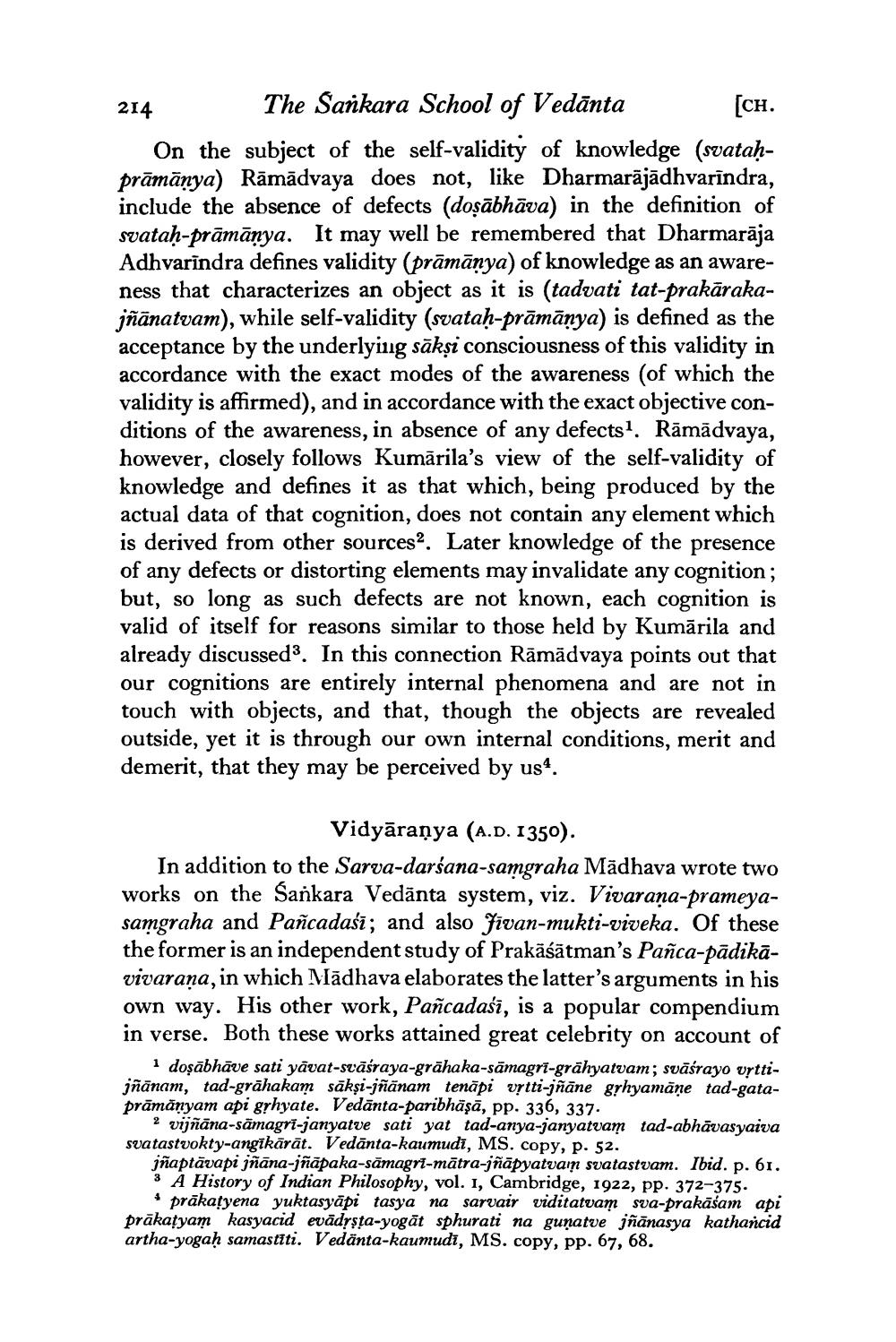________________
214
The Sankara School of Vedānta [CH. On the subject of the self-validity of knowledge (svatahprāmānya) Rāmādvaya does not, like Dharmarājādhvarīndra, include the absence of defects (doşābhāva) in the definition of svataḥ-prāmānya. It may well be remembered that Dharmarāja Adhvarīndra defines validity (prāmānya) of knowledge as an awareness that characterizes an object as it is (tadvati tat-prakārakajñānatvam), while self-validity (svatah-prāmānya) is defined as the acceptance by the underlying sākși consciousness of this validity in accordance with the exact modes of the awareness (of which the validity is affirmed), and in accordance with the exact objective conditions of the awareness, in absence of any defects?. Rāmādvaya, however, closely follows Kumārila's view of the self-validity of knowledge and defines it as that which, being produced by the actual data of that cognition, does not contain any element which is derived from other sources?. Later knowledge of the presence of any defects or distorting elements may invalidate any cognition; but, so long as such defects are not known, each cognition is valid of itself for reasons similar to those held by Kumārila and already discussed. In this connection Rāmādvaya points out that our cognitions are entirely internal phenomena and are not in touch with objects, and that, though the objects are revealed outside, yet it is through our own internal conditions, merit and demerit, that they may be perceived by us.
Vidyāranya (A.D. 1350). In addition to the Sarva-darśana-samgraha Madhava wrote two works on the Sankara Vedānta system, viz. Vivarana-prameyasamgraha and Pañcadasī; and also Jivan-mukti-viveka. Of these the former is an independent study of Prakāśātman's Pañca-pādikāvivarana, in which Madhava elaborates the latter's arguments in his own way. His other work, Pañcadasī, is a popular compendium in verse. Both these works attained great celebrity on account of
i doşābhāve sati yāvat-stāšraya-grāhaka-sāmagrī-grāhyatvam; svāśrayo urttijñānam, tad-grāhakam sāksi-jñānam tenāpi vrtti-jñāne grhyamāne tad-gataprāmānyam api gļhyate. Vedānta-paribhāsā, pp. 336, 337.
2 vijñāna-sämagri-janyatve sati yat tad-anya-janyatvam tad-abhāvasyaiva svatastvokty-angīkārāt. Vedānta-kaumudi, MS. copy, p. 52.
jñaptāvapi jñāna-jñāpaka-sāmagri-mātra-jñāpyatvain svatastvam. Ibid. p. 61. 3 A History of Indian Philosophy, vol. 1, Cambridge, 1922, pp. 372-375.
prākatyena yuktasyāpi tasya na sarvair viditatvam sva-prakāśam api prākatyam kasyacid evädrsta-yogāt sphurati na gunatve jñānasya kathancid artha-yogaḥ samastiti. Vedänta-kaumudi, MS. copy, pp. 67, 68.
spojenyabian
amegni-mici




